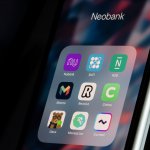Can Neobanks Survive the Coming Recession?

Neobanks were among the technological winners of the covid-19 pandemic. With the world practically shut down to avoid spreading the virus and prolonging the danger, new banks that could be operated from an app on your smartphone, that let you do at least the basics that most people need from a bank (pay money in, allocate money out, etc) were an easy way to keep the lights on and the bills paid, when traditional face-to-face banking was no longer an option.
The sector sprouted into international mega-growth, small players growing larger as they captured more and more accounts, and for a while it looked as though neobanking would evolve to deliver a coup to traditional banking models. If they could overcome some licensing issues that would allow them to offer a broader range of services via what is usually an app with a largely hidden staff infrastructure and no branch network, they could take on one of the world’s oldest industries and beat it at its own game in the 21st century.
Since then, though, several of the leading players in neobanking around the world have run into trouble. Relentless growth over a fairly short timeframe has meant increasing staff, technological update, and marketing costs, even without brank networks and buildings to worry about. And several neobanks, like Varo Bank and MoneyLion in the US, have encountered problems with cashflow, having offered their services free to win accounts, but then struggled with how to turn that offering into a revenue stream.
Even Chime, the leading neobank in the US, has been forced to exercise caution, delaying its IPO after stock valuations in the fintech sector significantly declined in the first half of 2022.
The Fintech Fightback
It’s also true that that both the traditional banking sector and the megafintechs, like Paypal and Square Cash, have yet to really lift a finger in retaliation against the upstart newcomers, because neobanks have barely captured any significant market share as “banks of first resort.” Traditional banks in particular are expected to start launching their neobank-equivalent apps in the final quarter of 2022, with the added bonus of being able to deliver advanced lending, mortgages, profit-generation and the like, which is likely to squeeze the neobanks’ USP and leave them with no option but to engage in costly change, or go to the wall.
The Coming Recession
So, neobanks were facing an uphill struggle in many territories in late 2022/2023 in any case. Only 5% of the neobanks currently in existence are thought to be breaking even, let alone making a profit. Ironically perhaps, Canada, the UK and the APAC region had the best potential outlook for the neobank model, the first two because of legislative changes that allow for their growth and evolution into fuller banking models, and the APAC region because of a greater cultural acceptance of high-tech solutions to the problems of day-to-day life, driving a more organic take-up and evolution model.
And now, both the US, Europe, and the UK are forecast to enter into recession in either late 2022 or early 2023, which begs the question of whether neobanks can survive this additional pressure on their business model. Will they remain either crucial or viable as the cost of living increases, the cost of trading intensifies, and the money supply shrinks? How will the coming recession impact the neobanks’ existing struggle for cashflow, and their already steep struggle to be the ‘first’ bank of many people – the most crucial way they deal with their day to day or monthly bills? As they came into their own during the Covid crisis, is there even a way in which the neobanks could rise to the surface during a second time of crisis?
The Nature of the Storm
A lot of what happens to neobanks during and after the recession will depend on how that recession looks, how long it lasts and how deep it cuts. If it’s just a technical recession – as is currently predicted in the US – it’s likely that the recession itself won’t have too much of an impact on the neobanks. A technical recession is two quarters of negative growth, one after the other, and the reason that might not have too much of an effect on the neobanks is, oddly enough, the reason why lots of the pre-existing threats, like a failure to monetize and a failure to become the ‘first bank’ for lots of people, might hurt them more.
There’s little technical impact from a short recession because the ties that link neobanks to their customers are nebulous – not to say, meaningless. There’s usually no payment required to use the services of a neobank, so there’s no revenue-stream from direct payment to be withdrawn, and in a short, technical recession, it’s unlikely that many customers will pull their funds from their neobank account into their more traditional bank accounts to deal with the daily, weekly and monthly expenses that are being squeezed.
The longer the neobanks’ customer accounts remain open and have money in them, the more of a buffer the neobanks will have against unfavorable stock valuations, because they’ll still look like fully functioning banks – albeit banks on the neo-model.
The Long Winter of the Neobank?
If the recession is longer than two quarters, and if it starts to bite into the already pressurized cost of living, then the neobanks may find themselves in real trouble. If people pull funds from what is likely to be their secondary or even tertiary account, their neobank account, to afford rent or mortgage payments, groceries, or power, then not only do the neobanks look less like functioning banks, but they face the potential closure of accounts, as customers reason that they need to retreat to their main banks to ride out the recession.
Any significant number of account closures as a result of the recession could unduly punish the neobanks and their stock valuations. In combination with, for instance, traditional banks (who still capture a majority of Generation X and above as their ‘first bank’) and fintechs (who still capture a majority of millennials and Generation Z) offering their own neobank-like services from an existing ‘first bank’ platform, those stock devaluations might not only exacerbate the revenue-steam issue of even the leading neobanks, it might conceivably pull several players, up and down the scale, entirely apart.
Recessions famously eat savings, because stored money is released to current accounts to help people weather the storm. If the coming recession is too long, or too harsh, the money in the neobanks’ customers’ accounts might evaporate similarly quickly, and the first big wave of global neobanking might be forced to an ignominious end.










